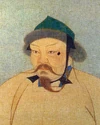
|
This Knightfall page is a Proposal.
It has not been ratified and is therefore not yet a part of the Knightfall Timeline. You are welcome to correct errors and/or comment at the Talk Page. If you add this label to an article, please do not forget to make mention of it on the Main Discussion page for the Timeline. |
| Novgorod Republic Новгородскаѧ земьлѧ
Novgorodskaya Zemlja Timeline: Knightfall
OTL equivalent: Novgorod Republic | |||||
|---|---|---|---|---|---|
|
|||||
| Capital | Veliky Novgorod | ||||
| Official languages | Old East Slavic | ||||
| Regional languages | Sápmi | ||||
| Demonym | Novgorodian | ||||
| Government | Mixed | ||||
| - | Prince | Sviatoslav Olgovich (1136–1138) | |||
The Novgorod Republic (Russian: Новгоро́дская респу́блика, Translated: Novgorodskaja respublika) is a large Russian state which its domain extends from the Ural Mountains to the Eastern Baltic Sea. It included mainly the city of Novgorod, the capital, and regions around Lake Lagoda. The Republic was famed and thrived as the easternmost part and port of the Hanseatic League, or the Hansa.
History[]
See Also: Kievan Rus'
Pre-1248
For a detailed overview of Novgorod before 1248, click here .
Thirteenth Century[]
Fourteenth Century[]
Fifth Century[]
Fall of the Republic[]
Government[]
The Novgorodian Republic was made up of a network of public assemblies, mayors, tysyatskys (originally of the head of a town militia, but later an appointed office), members of aristrocratic families, and Orthodox archbishops in the region of Novgorod. There was a Council of Lords, who led the executive branch of the government, who was in turn led by the archbishop. The council met in the archiepiscopal palace. However, the head executives was always the Prince of Novgorod, who was invited by Novgorodians from nearby states. The Archbishop who led the council created embassies, saw over court cases, and acted on other non-religious services. He was always supposed to consult boyars. The archbishop was not appointed, but elected by Novgorodians and approved by the Bishop of Russia. These archbishops were the richest aristocrats in Novgorod and also made profit off court fees, taxes, and through other ways.
Another very important position was the Posadnik, who carried out the public assembilies, charied with the prince, made sure tax collection was being brought through and managed affairs of the city. Almost all of the Prince's major decisions needed to be approved by this man
Foreign Relations[]
Mongol Relations[]
Culture[]
Literature[]
Scholars generally believe that the Republic of Novgorod had an unusually high level of literacy for the time period. Archeologists found over one thousand birch-bark texts, all dating from the 11th to the 15th centuries, in towns dating back to the early Rus'. Roughly 950 of these texts were from Novgorod. Archeologists and scholars assume that Mongol fires in the 1280s destroyed a majority of Novgorod’s written works and that about 20,000 similar texts still remain hidden in the city. Novgorod citizens from all class levels, from boyars to peasants and artisans to merchants, participated in writing these texts. Even women wrote a significant amount of the manuscripts. This collection of birch-bark texts consists of religious documents, writings from the city’s archbishops, business messages from all classes, and travelogues, especially of religious pilgrimages.
| ||||||||||||||



